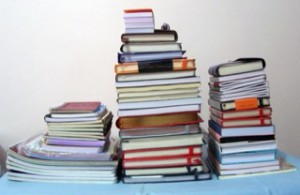
Yesterday, I said that I’d found a better way to keep a combination writer’s notebook and Capture Device (from GTD.) A way so simple, so elegant, so fuel-efficient that I can envision myself using it for years to come. I found the method on Pinterest. It’s detailed in this article in the English-language version of The Tokyo Times, which says:
This little useful hack was taught in Japan but it’s a bit messy. Also, it’s something most people will not find themselves doing all the time, but it may come in handy for the right subject.
The key words are “handy for the right subject.” I think it’s perfect for a combined Capture Device and writer’s notebook (and it’s really not messy.) Here’s what you do:
Step 1. Get a ruled notebook. Doesn’t matter if it’s a drugstore spiral-bound one or a fancy notebook like this beauty. Doesn’t matter what size, but it should be one that gives you enough room to write in and that you’re comfortable carrying around in your handbag, backpack, man bag, computer sleeve, briefcase, or tote bag.
Step 2. Follow the easy instructions in The Tokyo Times article (which I’ll expound upon below) to use the notebook. It will automatically make finding everything you need super fast and easy.
The article’s example is for a recipe book. But we’re using it for a writer’s notebook, as well as capturing on paper all the other reminders and miscellaneous stuff that floats up to our consciousness throughout the day. How would it work in actual practice?
Let’s say you’re using your notebook for the first time, and you’re at a writers’ conference. The speaker’s topic is marketing, and she scribbles some interesting links on the whiteboard that you’d like to save. You’d open your notebook and jot them down on the first page. You’d flip to the last page of your notebook and write “Marketing” on the first line. Flip back to the first page and make a mark on the right-hand margin, on exactly the same line that you used in the back of the book [tip: put an index card between the pages so you won’t accidentally mark the next page.] (See photos, below.)
What if some of the links are also about making attractive book covers? No problem. Flip to the last page. On the second line under “Marketing,” write “Book Covers.” Go back to the first page and make a second mark on the right-hand margin. Make it on the second line, which is exactly the same line as your “Book Covers” heading in the back of the book.
Look how the “cook” did this with the recipes he collected:
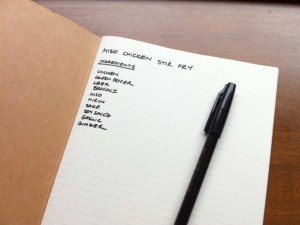
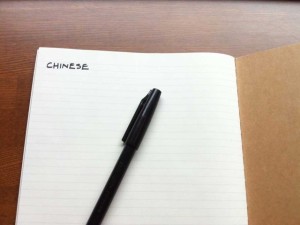
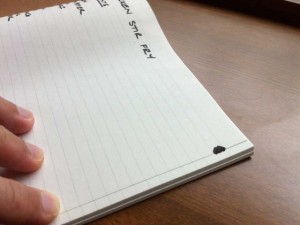
This will take just a tiny bit more time than jotting down the links from the whiteboard. Yet, as you continue to use your notebook this way, you will end up with a simple method to find everything you need, just like the cook who collected recipes in the article. It will all be automatically indexed!
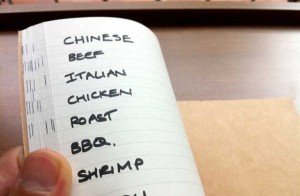
You may have noticed a possible downside to this. Your categories – the ones you list on the back page – are limited to the number of lines on the page. Be sure, then, to get a notebook with plenty of lines per page.
Now, here’s the Eureka! moment I had when I realized this could be a combination Capture Device/writer’s notebook. Observe: Continuing on to your second day of using this system, let’s say you’re in your car at the dry cleaner’s window dropping off the cleaning. You suddenly realize that you need to bring in the guest bedroom’s comforter for cleaning when you return for the cleaned items on Tuesday.
You’d open your notebook to page two (because page one has the links from the writer’s conference the day before.) You’d write, “Take comforter to cleaners on Tuesday, and pick up cleaned clothes.” Then you’d simply flip to the last page and write “Calendar” under the two previous categories (“Marketing” and “Book Covers.”) Flip back to page two and make the little mark on the right-hand margin on line three, the same line on which you wrote “Calendar.” Since this is not a writer’s notebook entry, but an item for the Capture Device, at a later time when you’re ready to update your calendar, you’ll easily find and transfer every item entered for the Calendar category.
The advantage to this, over the GTD Capture Device, is that you don’t have to hunt to find a Calendar entry among the To-Do items, Birthday Gift Ideas, and Recipes, etc. If you’re ready to update your calendar, you only want to see the Calendar entries, right? And here they will be, already indexed.

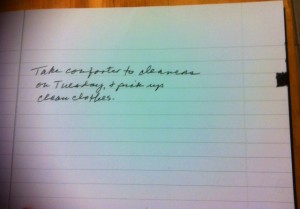

Fuel-Efficiency achieved.
I’ve tried lots of ways to keep track of myself, but until I saw this “little Japanese hack,” I knew I’d never succeed because the planner systems were so time-consuming and often required duplication of effort. What, if anything, have you found that works for you?
P.S. If you decide to try this system, I’d love to know how it works out.

I think this is awesome. I actually think I’m going to try a derivation of it using color-coding and use it on all my filled-in notebooks. Thank you so much!
Its adaptability is one of things I really like about this “little Japanese hack.” Since I started using it for myself I keep thinking, “This is too easy.” And then I remember, “That’s the point.” 🙂 Hope the color-coding works for you. 🙂
Thanks! I think it will make it easier since I have so many flipping notebooks. I’m looking forward to trying it! 🙂
Took me a minute to figure out the marks on the edge of the page, but then it was so clear. Genius idea.
I know, right? It’s so simple to use, and you’ll never have to thumb through page after page to find what you need!
WIN WIN WIN WIN!!! Mwahhahaaaaaa!
Ahem. Thank you, Rebekah! 🙂
I lead such a simple life that all such fripperies are unnecessary. (Haw, haw)
This is a great idea, used a lot in car manuals and the like, but not quite like you have it.
Thanks for the idea
“Fripperies” – love it, Gordon 🙂
Of course, in car manuals and the like, the method is used to mark *sections* of the book.
With “this little Japanese hack,” you don’t need a section dedicated to, e.g., “To-Do Lists.” You can jot a “To-Do” item anywhere, on any page. Later on, you can easily find them all, or just the most recent ones.
It’s amazingly simple. <3